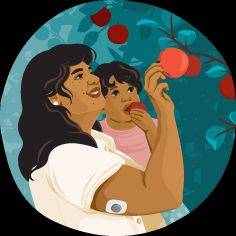Breast eczema may affect any part of the breast, such as the nipples, sides, and folds underneath. It may be caused by external bacteria, allergens, and irritants. Treatments can help manage symptoms.
Eczema is a group of chronic skin conditions that may cause dry, itchy, and inflamed patches of skin.
It most commonly affects children ages 2 months to 5 years, but adolescents and adults may also have eczema. The location of symptoms may depend on your age, but they usually appear on the face, scalp, arms, and torso.
Eczema can also affect the breast. Symptoms typically appear on the nipple, but may also affect the surrounding areas, such as the sides, folds beneath, and the chest.
Keep reading to learn more about the symptoms, causes, triggers, and treatments for breast eczema.
Eczema on the breast is a common cause of nipple itchiness. It most commonly affects the nipple and the areola, the circular area around it.
Symptoms can also occur under or in between your breasts and on the rest of your chest.
Symptoms of breast eczema are similar to those that can affect the rest of your body, including:
- itching
- dry, cracked, or scaly skin
- skin discoloration (red or brownish-gray areas) under, in between, or on your breasts
- small bumps that may ooze and crust over
- swollen, tender, or sensitive skin
Breast eczema is most commonly diagnosed in adolescents, but it can affect people of all ages.
Speak with a healthcare professional if you experience any of these symptoms. They could assess your symptoms, provide a diagnosis, and help develop a treatment plan for you.
Breast eczema is
These dermatoses all affect the function of your skin barrier. This is the outer layer of skin that helps keep your skin moisturized by preventing water from evaporating and protecting it from environmental irritants.
The exact cause of these dermatoses and skin barrier dysfunction is unknown, but
- environmental irritants, such as detergents, soaps, certain clothing materials, sweat, and perfumes
- genetic mutations that affect the skin barrier or immune system
- family history of eczema, asthma, or allergies
- stress
- infections
Learn more about what causes eczema to flare up.
A healthcare professional will start by examining your breast area for symptoms of eczema. In most cases, they can diagnose eczema by visual examination alone.
However, sometimes they may perform other tests to rule out other possible causes of your symptoms, such as allergies, infections, or Paget disease. These tests may include:
There’s currently no cure for breast eczema, but at-home remedies and medical treatments could help relieve your symptoms and improve your quality of life. Your treatment plan will depend on the severity of your symptoms.
Home remedies
Some at-home remedies to help relieve breast eczema may include:
- moisturizing your skin multiple times a day with fragrance-free emollients, ointments, creams, or lotions
- avoiding possible triggers, such as sweat, harsh soaps and detergents, and pollen
- taking a colloidal bath, bleach bath, or warm (not hot) bath for less than 15 minutes
- applying natural oils, such as coconut oil, tea tree oil (which is an essential oil and should be diluted in a carrier oil before use), and aloe vera
- reducing stress, such as meditating, writing in a journal, and speaking with a therapist
It’s best to speak with a healthcare professional before trying any home remedies for eczema. If your symptoms persist after trying these, they may recommend medical treatments.
Learn more about home remedies for eczema.
Medical treatments
If home remedies alone don’t help relieve breast eczema symptoms, a doctor may recommend topical medications like a steroid cream to help relieve symptoms.
If you’re nursing, it’s important to apply the cream afterward.
A doctor may also prescribe antibiotics if you have a breast eczema infection. Skin infections are characterized by red streaks, yellow scabs, or pus in the affected area.
Learn more about medical treatments for eczema.
In rare cases, itchiness of the nipples may indicate Paget disease of the breast. This is a rare form of breast cancer that starts in the nipple and extends to the areola (the dark area of skin around the nipple).
Paget disease of the breast is commonly misdiagnosed as eczema of the breast or nipple, as the first symptoms are typically a red, scaly rash of the skin. Other symptoms may include:
- crusty, flaky, thickening, or oozing skin on the nipple and/or areola
- itching, burning, or tingling sensations
- an ulcer, which may cause bloody or yellow discharge from the nipple
- inverted nipple
- a lump behind the nipple or in the breast
It’s important to speak with a doctor if you experience any of these symptoms. They can assess your symptoms to provide a proper diagnosis and develop an appropriate treatment plan.
Breast eczema is when you experience dry, itchy, and flaky skin patches in the breast area, such as the nipples, chest, or the folds beneath the breast.
With proper treatment, breast eczema can be managed efficiently. However, you should identify and always be aware of your triggers, as they may cause the condition to return.
If you experience more severe symptoms, speak with a doctor. They can evaluate your symptoms and develop a treatment plan for you.




